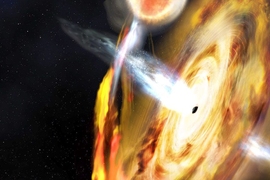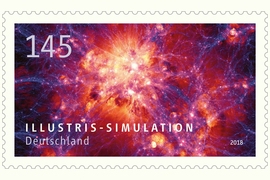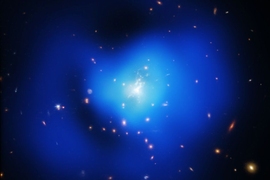Scientists at the MIT Kavli Institute for Astrophysics and Space Research are part of a team that has discovered 13 fast radio bursts (FRBs), as well as the second repeating FRB ever recorded, using a revolutionary radio telescope.
FRBs are short flashes of radio waves coming from far outside our Milky Way galaxy. Scientists believe FRBs emanate from powerful astrophysical phenomena billions of light years away, but they have yet to determine their origin.
These discoveries are among the first, eagerly awaited results from the Canadian Hydrogen Intensity Mapping Experiment (CHIME), a revolutionary radio telescope inaugurated in late 2017 by a collaboration of scientists that includes MIT’s Kiyoshi Masui, an assistant professor of physics, and Juan Mena Parra, a Kavli postdoc.
Masui and Mena Parra joined the MIT School of Science last fall from the University of British Columbia and McGill University respectively, where they worked on the Canadian-led project for the past five years.
In two papers published today in Nature and presented the same day at the American Astronomical Society meeting in Seattle, the researchers present data from the 13 bursts while CHIME was in its precommissioning phase and running at only a fraction of its full capacity.
A new way of building radio telescopes
In 2007, astronomers discovered a new phenomenon that they called an FRB. Data recorded several years earlier by the Parkes Radio Telescope in Australia showed a fleeting but powerful radio emission coming from an unidentified source in space.
Since the first discovery a decade earlier, roughly 60 bursts have been observed by five different telescopes worldwide. In stark contrast, the data presented today from 13 bursts was collected over a period of only three weeks during the summer of 2018. The scientists also discovered repeat bursts from one of the 13 sources, a discovery only made once before.
The stunning rate at which CHIME detected the FRBs is due to its revolutionary design.
“The telescope has no moving parts. Instead it uses digital signal processing to ‘point’ the telescope and reconstruct where the radio waves are coming from,” says Masui. “This is done using clever algorithms and a couple of giant computer clusters that sit beside the telescope and crunch away at the data in real time.”
Physics professor Max Tegmark pioneered these kinds of telescopes. He led a study in 2009 that worked out the details of how such a telescope would work. He also led the construction of a prototype telescope, MITEoR, that tested algorithms and calibration techniques. With CHIME, this concept for telescope design comes of age and is being used for breakthrough science to detect FRBs.
Discovery of second repeating FRB suggests more exist
Of the FRBs observed to date, repeating bursts from a single source had been found only once before — a discovery made by the Arecibo radio telescope in Puerto Rico in 2015.
“Until now, there was only one known repeating FRB. Knowing that there is another suggests that there could be more out there. And with more repeaters available for study, we may be able to understand these cosmic puzzles a bit better — where they’re from, what causes them, and why,” says Ingrid Stairs, a member of the CHIME team and an astrophysicist at University of British Columbia.
Before CHIME began to gather data, some scientists wondered if the range of radio frequencies the telescope had been designed to detect would be too low to pick up fast radio bursts. Most of the FRBs previously detected had been found at frequencies near 1,400 megahertz, well above the Canadian telescope’s range of 400 megahertz to 800 megahertz.
The CHIME team’s recent results settles these doubts, with the majority of the 13 bursts being recorded well down to the lowest frequencies in CHIME’s range. In some of the 13 cases, the signal at the lower end of the band was so bright that it seems likely other FRBs will be detected at frequencies even lower than CHIME’s minimum of 400 megahertz.
FRB sources likely to be in "special places" within galaxies
Ever since FRBs were first detected, scientists have been piecing together the signals’ observed characteristics to come up with models that might explain the sources of the mysterious bursts and provide some idea of the environments in which they occur. The detection by CHIME of FRBs at lower frequencies means some of these theories will need to be reconsidered.
The majority of the 13 FRBs detected showed signs of “scattering,” a phenomenon that reveals information about the environment surrounding a source of radio waves. CHIME measures scattering more precisely than other instruments because it operates at lower frequencies. The amount of scattering observed by the CHIME team led them to conclude that the sources of FRBs are powerful astrophysical objects more likely to be in locations with special characteristics.
“That could mean in some sort of dense clump like a supernova remnant,” says team member Cherry Ng, an astronomer at the University of Toronto. “Or near the central black hole in a galaxy. But it has to be in some special place to give us all the scattering that we see.”
CHIME is a collaboration of more than 50 scientists led by the University of British Columbia, McGill University, University of Toronto, and the National Research Council of Canada (NRC). The $16-million investment for CHIME was provided by the Canada Foundation for Innovation and the governments of British Columbia, Ontario and Quebec, with additional funding from the Dunlap Institute, the Natural Sciences and Engineering Research Council and the Canadian Institute for Advanced Research. The telescope is located in the mountains of British Columbia’s Okanagan Valley at the NRC’s Dominion Radio Astrophysical Observatory near Penticton.
This article is adapated from a press release issued by McGill University.










